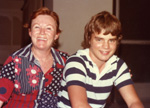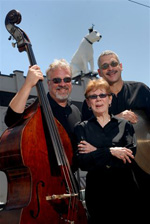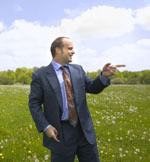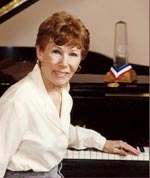 |
|
"(John) was a joy and a wonderful musical challenge, which I needed at that time to keep my spirits hopeful...”
"...Lee was absolutely the best thing that could ever have happened for me. She was an incredible teacher and she provided me with a solid, perfect foundation.”
"I’m very excited to do it, because I’m always meaning to go up and visit Lee and connect with her and hang out and play with her and talk music..."
|
John, how old were you when you came to Lee, and what piano players were you listening to at the time? MEDESKI: “I was 12 or 13. I was really just playing a lot of classical music, so I was listening to a lot of classical artists and some piano players that my parents were into, like Peter Nero, Frankie Carl, Carmen Cavallaro – not much jazz. What happened was that I heard Oscar Peterson’s music at a friend’s house, and my friend was playing some of the same tunes that these guys were playing, and it blew my mind. From there, I realized that there’s a whole other way to play, and I knew I wanted to play jazz.” How did you hook up with Lee as a teacher? MEDESKI: “I told my parents that I wanted to take jazz piano and my mom found Lee.” Lee, where were you in your career at that time? Were you teaching fulltime, or was it something you did between gigs? SHAW: “Moving to Florida was not of our choosing, and produced disastrous career results from which it was very difficult to recover. We moved because both of my husband's parents were diagnosed with cancer and needed our being there to help. My mother living alone in Oklahoma had been mugged on her way home from the grocery store, and could not live alone any longer. So we moved to Florida with my mother and spent much time in hospitals taking care of his parents and taking care of my mother. We had developed contacts among agents in New York City who were becoming very interested in us, and were starting to give us good opportunities. The move to Florida meant we could no longer travel and so our contacts stopped calling us. The popularity of Jazz in Florida was on the wane again, and there were very few clubs in which we could play. My involvement in the music consisted of my own study at home, an occasional trio gig, and the students I had. John was, blessedly, among those students, and (he was) one of the most talented and motivated students I ever had. He was a joy and a wonderful musical challenge, which I needed at that time to keep my spirits hopeful. I had never wanted to become a full time teacher; I wanted to play with my trio, full time. Meeting and teaching John was one of the few bright experiences there.” When you take on a student, what direction do you take? Do you work with the student’s musical preferences, or do you try and steer them toward your own area of musical interests? SHAW: “As a teacher, I try to get to know the student: What is his taste? Does he want to be a professional musician or not, and why? What is his background (training)? How motivated and serious? I try to present to the student the things that need to be a firm part of his vocabulary in order to fulfill his own desires, and introduce the student to the multitude of musicians who play the kind of music which attracts him. The experience with me is about the student and the students learning, not my trying to convince the student to move in my preferred direction, but his preferred direction.” Okay, Brass Tacks time: Lee, how was John as a pupil? SHAW: “Hungry. Wide open to learning new worlds of music. Very responsive to my suggestions and illustrations of improvising freely at the piano. Dedicated and very willing to concentrate on my suggestions: Records to listen to, exercises to practice, vocabulary to learn, voicings to learn, transcribing to do. I can't remember if he was studying with a classical teacher also at that time, but continuing to develop his technique, and building jazz repertoire.” And, conversely, John, how was Lee as a teacher? MEDESKI: “I think Lee was absolutely the best thing that could ever have happened for me. She was an incredible teacher and she provided me with a solid, perfect foundation.” How long did you two work together? Was it a steady deal – once a week, once a month – or was it catch-as-catch-can? SHAW: “I seem to remember that we were together a couple of years before I moved back to the Albany area. I believe the lesson were every week, or every other week for that period of time. My husband and I made frequent trips to Florida, and whenever we did, I always headed to John's house and we were at the piano, working on whatever he needed at that time.” John, what’s the single, best lesson you got from working with Lee? MEDESKI: “Lee had me, as part of my practice, play freely after I warmed up. She said to make that be the first thing you do when you practice. It’s an incredible way to get in touch with your own connection to improvised music and everything it means to you. She had me play free, record it, and go back and listen to it. It really helped me to open the doors to personalize these techniques and chords, which I think is the most important thing in music – to have that connection. This was one of the best lessons I ever got from Lee. Another thing she taught me was to say yes to any gig – even if you don’t know how to do it – and then learn how to do it in order to grow.” Lee, what’s the single, best lesson you got from one of your teachers – be it Oscar Peterson or someone else? SHAW: “(What I) learned from Oscar: Listen. Listen. Articulation, be inventive; touch, beat; learn to be my best critic.” Have you two kept in touch over the years? MEDESKI: “Yes, we’ve kept in touch to see what each other are doing. It never feels like we’re in touch enough, but I still feel connected to her from the time we spent together. I’m very grateful and very lucky.” SHAW: “In the past few years, I have been in touch with John's mother, and she has sent me articles and information on the activities of Medeski Martin and Wood.” Let’s talk about this show: How did it come about? Who came up with the idea? SHAW: “The idea was from Rich Syracuse, my bassist and friend for many years. He asked me if I would like to do a program with John. ‘Yes.’ Then I got in touch with John, and with Peter Lesser at the Egg.” Have you two talked about what material you’re going to do? Will you get a chance to rehearse together, or will you just go onstage and leave it to the fates? SHAW: “We will be getting together this coming Friday to talk about the show and talk about material.” MEDESKI: “We will rehearse together; we have talked about some material, and it will all come together in the rehearsal. We’ll do originals of both of ours, as well as some classics. As with any improvised music, there will be a lot left to the fates.” What would you both like to come out of this show? Also, what’s your individual excitement level about working together again – this time as contemporaries? SHAW: “I believe that the coming show will be a joyful reunion, each of us in our own place, with our individual vocabularies and with a rhythm section which is compromised of two of the most talented and sympathetic of bassists and drummers, Rich Syracuse and Jeff Siegel.” MEDESKI: “I’m very excited to do it, because I’m always meaning to go up and visit Lee and connect with her and hang out and play with her and talk music, and it’s been really hard to make it happen with my schedule. I’m hoping this will be the opportunity to do that, and maybe it will help us to do it more often. I don’t consider us contemporaries; I still consider myself her student. I still have a lot to learn.” J HUNTER is a former announcer/producer for radio stations in the Capital Region and the Bay Area, including KSJS/San Jose (where he was Assistant Music Director/Jazz Programming) and Q104 WQBK/Albany. He is a frequent contributor to the web site All About Jazz and to the monthly music magazine State of Mind. He currently resides in Clifton Park. |



